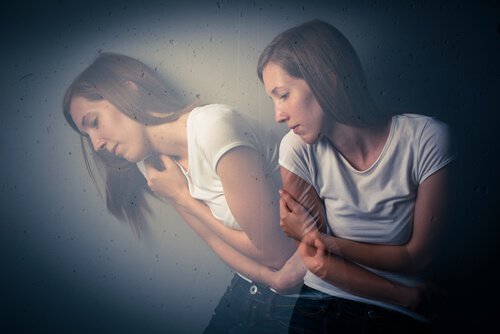Do You Know the Difference Between Adaptive and Pathological Anxiety?

It is important to know that there are different types of anxiety. On the one hand we have pathological anxiety, sometime called dysfunctional. And on the other we have adaptive anxiety, known as “normal” anxiety. It’s important to know because people often think that all types of anxiety are negative.
In general terms, we can define anxiety as an emotional state that is a result of some sort of harm or misfortune. In other words, it occurs when someone thinks that something bad will happen. These thoughts can cause us great worry. It shows itself as emotional discomfort, something like a mixture of fear, restlessness and nervousness. There can also be physical symptoms, such as palpitations, nausea, and dizziness.
In adaptive anxiety, the expected suffering is a real probability. For example, when we know that we’ll be late for work and we expect to be rebuked for it. In pathological anxiety, on the other hand, there is emotional discomfort in the face of future damage that is possible, but not probable. Because of this, it becomes pretty much a permanent state. In other words, we expect something bad to happen to us constantly.
“The intensity of the anguish is proportional to the meaning that the situation has for the affected person, even though they aren’t aware of the reasons for their anxiety. “
-Karen Horney-

The role of anxiety
Adaptive anxiety is an in-built part of us. Its role is to protect us in order to guarantee our integrity and survival. When there is a real threat, both the body and the mind must prepare to face it. If we aren’t prepared in this way then a great feeling of helplessness floods us when the danger actually appears. Anxiety, then, has some positive purposes.
Pathological anxiety occurs when the person feels incapable of facing a threat. They also perceive threats in situations that are not real. When this happens persistently, you enter a state of anguish. In this anguish you don’t even know what you are afraid of. You simply feel fear because “something” may occur.
A state of anxiety produces many physiological changes in our bodies. We need several of our organs (our heart, kidneys and lungs, for example) to be able to work at great intensity in order to face the threat. If someone experiences anxiety on a frequent basis then it is quite normal for our bodies to be adversely affected. Illness is a common result of this type of anxiety.
Characteristics of pathological anxiety
Those who suffer from pathological anxiety have a serious problem. It is not enough to give them a pat on the shoulder and tell them that everything will be fine. Escaping from this state requires much more than the goodwill of others.
The first thing to begin to unravel the problem is to know if what you have can be diagnosed as pathological anxiety. To know this for sure we must see whether the tension we are experiencing meets the following characteristics:
- Frequency and intensity. In pathological anxiety there are frequent episodes of anxiety, which are usually prolonged and we can experience them with high intensity. In adaptive anxiety, on the other hand, episodes are rare, pass quickly and are not as intense.
- Responses. In pathological anxiety there are disproportionate responses to the stimulus that provokes that state, whether it be real or imaginary. For example, being afraid of thieves entering the house and spending the whole night trying to make sure it doesn’t happen.
- Suffering. When anxiety is pathological, we experience it as a deep continuous suffering. In adaptive anxiety, suffering is temporary and leaves no trace.
- Functionality. Pathological anxiety affects our normal day to day lives. It either prevents us from taking action, or actually makes us take action. It does this in such a way that our routine is altered or limited, and confusion and fear fill our lives.

Why does anxiety become pathological?
Actually, the answer to this question could well fill several books. However, to sum things up, we could summarize by saying that behind this type of anxiety we can find unresolved trauma. Sometimes the relationship between trauma and anxiety is a direct one, but on other occasions it isn’t.
If someone, for example, is involved in a car accident, the event is likely to leave scars, and not just physical ones. It is quite normal for the victim of the accident to feel anxious every time they have to get in a car, or even when walking down a road. In this case, the relationship between trauma and anxiety is direct, albeit disproportionate if we consider the actual probability of threat.
In other cases, the trauma that gives rise to the pathological anxiety may be concealed, or inhibited in the unconscious. Rejection or abuse at an early age may be the cause.

Due to the above, pathological anxiety is a condition for which a person normally requires outside help to be able to be able to get over it. The most advisable thing is to contact a psychotherapist or a psychoanalyst to solve this problem.
It is important to know that there are different types of anxiety. On the one hand we have pathological anxiety, sometime called dysfunctional. And on the other we have adaptive anxiety, known as “normal” anxiety. It’s important to know because people often think that all types of anxiety are negative.
In general terms, we can define anxiety as an emotional state that is a result of some sort of harm or misfortune. In other words, it occurs when someone thinks that something bad will happen. These thoughts can cause us great worry. It shows itself as emotional discomfort, something like a mixture of fear, restlessness and nervousness. There can also be physical symptoms, such as palpitations, nausea, and dizziness.
In adaptive anxiety, the expected suffering is a real probability. For example, when we know that we’ll be late for work and we expect to be rebuked for it. In pathological anxiety, on the other hand, there is emotional discomfort in the face of future damage that is possible, but not probable. Because of this, it becomes pretty much a permanent state. In other words, we expect something bad to happen to us constantly.
“The intensity of the anguish is proportional to the meaning that the situation has for the affected person, even though they aren’t aware of the reasons for their anxiety. “
-Karen Horney-

The role of anxiety
Adaptive anxiety is an in-built part of us. Its role is to protect us in order to guarantee our integrity and survival. When there is a real threat, both the body and the mind must prepare to face it. If we aren’t prepared in this way then a great feeling of helplessness floods us when the danger actually appears. Anxiety, then, has some positive purposes.
Pathological anxiety occurs when the person feels incapable of facing a threat. They also perceive threats in situations that are not real. When this happens persistently, you enter a state of anguish. In this anguish you don’t even know what you are afraid of. You simply feel fear because “something” may occur.
A state of anxiety produces many physiological changes in our bodies. We need several of our organs (our heart, kidneys and lungs, for example) to be able to work at great intensity in order to face the threat. If someone experiences anxiety on a frequent basis then it is quite normal for our bodies to be adversely affected. Illness is a common result of this type of anxiety.
Characteristics of pathological anxiety
Those who suffer from pathological anxiety have a serious problem. It is not enough to give them a pat on the shoulder and tell them that everything will be fine. Escaping from this state requires much more than the goodwill of others.
The first thing to begin to unravel the problem is to know if what you have can be diagnosed as pathological anxiety. To know this for sure we must see whether the tension we are experiencing meets the following characteristics:
- Frequency and intensity. In pathological anxiety there are frequent episodes of anxiety, which are usually prolonged and we can experience them with high intensity. In adaptive anxiety, on the other hand, episodes are rare, pass quickly and are not as intense.
- Responses. In pathological anxiety there are disproportionate responses to the stimulus that provokes that state, whether it be real or imaginary. For example, being afraid of thieves entering the house and spending the whole night trying to make sure it doesn’t happen.
- Suffering. When anxiety is pathological, we experience it as a deep continuous suffering. In adaptive anxiety, suffering is temporary and leaves no trace.
- Functionality. Pathological anxiety affects our normal day to day lives. It either prevents us from taking action, or actually makes us take action. It does this in such a way that our routine is altered or limited, and confusion and fear fill our lives.

Why does anxiety become pathological?
Actually, the answer to this question could well fill several books. However, to sum things up, we could summarize by saying that behind this type of anxiety we can find unresolved trauma. Sometimes the relationship between trauma and anxiety is a direct one, but on other occasions it isn’t.
If someone, for example, is involved in a car accident, the event is likely to leave scars, and not just physical ones. It is quite normal for the victim of the accident to feel anxious every time they have to get in a car, or even when walking down a road. In this case, the relationship between trauma and anxiety is direct, albeit disproportionate if we consider the actual probability of threat.
In other cases, the trauma that gives rise to the pathological anxiety may be concealed, or inhibited in the unconscious. Rejection or abuse at an early age may be the cause.

Due to the above, pathological anxiety is a condition for which a person normally requires outside help to be able to be able to get over it. The most advisable thing is to contact a psychotherapist or a psychoanalyst to solve this problem.
This text is provided for informational purposes only and does not replace consultation with a professional. If in doubt, consult your specialist.







